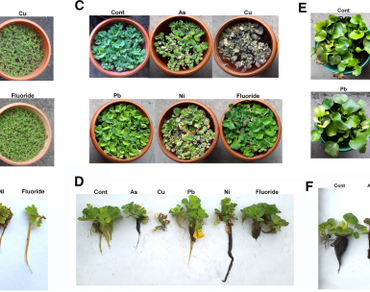Assessing the rhizofiltration potential of three aquatic plants exposed to fluoride and multiple heavy metal polluted water
Research Articles | Published: 02 June, 2022
First Page: 1158
Last Page: 1164
Views: 3418
Keywords: Heavy metals, Fluoride, Rhizofiltration, Biochemistry, Phytoextraction, Phytostabilization
Abstract
Heavy metals like arsenic, copper, lead and nickel and the non-metallic xenobiotic, fluoride are the major pollutants of aquatic ecosystems. All these pollutants exhibit high biomagnification along the food web and their consumption and usage have been widely warned against by almost all internationally regulated bodies. In order to alleviate the rising concern due to the use of polluted water, an eco-friendly, cheap and sustainable phytoremediative blueprint was designed by assaying the comparative rhizofiltration capacity of the three commonly found aquatic plants, viz., Azolla (water fern), Pistia (water lettuce) and Eichhornia (water hyacinth) in separate sets of polluted water samples. Interestingly, water lettuce exhibited highest phytoextraction and phytostabilization of arsenic, lead and fluoride, whereas water fern and water hyacinth ‘cleaned’ the nickel- and copper-polluted water sets, respectively with the highest efficiency among the tested species. Incidentally, this was due to the increased release of organic acids like citric and malic acids as root exudates which led to scavenging, root absorption/adsorption or sedimentation of the pollutants. Water lettuce was identified as an efficient hyperaccumulator of fluoride with a translocation factor of 5.0 and yet the overall biomass was unaffected due to phytostabilization of the toxicant. Due to significant bioaccumulation of the xenobiotics, the root and shoot length of the tested species were variably affected. Overall, the present work advocated the use of distinct plant species for efficiently ‘cleaning’ and de-polluting variable xenobiotic toxicants commonly available in the aquatic environment.

References
Banerjee A, Roychoudhury A (2021) Differential lead-fluoride and nickel-fluoride uptake in co-polluted soil variably affects the overall physiome in an aromatic rice cultivar. Environ Pollut 268:115504
Banerjee A, Samanta S, Singh A, Roychoudhury A (2020) Deciphering the molecular mechanism behind stimulated co-uptake of arsenic and fluoride from soil, associated toxicity, defence and glyoxalase machineries in arsenic-tolerant rice. J Hazard Mater 390:121978
Farajzadeh MA, Nagizadeh S (2002) Citric acid determination by dual wavelength spectrophotometry. J Chin Chem Soc 49:619–624
Karlova R, Boer D, Hayes S, Testerink C (2021) Root plasticity under abiotic stress. Plant Physiol 187:1057–1070
Koo B-J, Adriano DC, Bolan NS, Barton CD (2005) Root exudates and microorganisms. In: Hillel D (ed) Encyclopedia of soils in the environment. Academic Press, Elsevier, United Kingdom, pp 421–428
Posthuma L, Zijp MC, Zwart DD, Meent DV, Globevnik L, Koprivsek M, Focks A, Gils JV, Birk S (2020) Chemical pollution imposes limitations to the ecological status of European surface waters. Sci Rep 10:14825
Rehman K, Fatima F, Waheed I, Akash MSH (2018) Prevalence of exposure of heavy metals and their impact on health consequences. J Cell Biochem 119:157–184
Samanta S, Singh A, Banerjee A, Roychoudhury A (2020) Exogenous supplementation of melatonin alters representative organic acids and enzymes of respiratory cycle as well as sugar metabolism during arsenic stress in two contrasting indica rice cultivars. J Biotechnol 324:220–232
Selvi A, Rajasekar A, Theerthagiri J, Ananthaselvam A, Sathishkumar K, Madhavan J, Rahman PKSM (2019) Integrated remediation processes toward heavy metal removal/recovery from various environments—a review. Front Environ Sci 7:66
Sood A, Uniyal PL, Prasanna R, Ahluwalia AS (2012) Phytoremediation potential of aquatic macrophyte, Azolla. Ambio 41:122–137
Srivastava S, Anand V, Singh P, Roy A, Pallavi S, Bist V et al (2021) Microbial systems as a source of novel genes for enhanced phytoremediation of contaminated soils. In: Kumar A, Singh VK, Singh P, Mishra VK (eds) Microbe mediated remediation of environmental contaminants. Woodhead Publishing, Elsevier, Netherlands, pp 177–198
Usman K, Al-Ghouti MA, Abu-Dieyeh MH (2019) The assessment of cadmium, chromium, copper, and nickel tolerance and bioaccumulation by shrub plant Tetraena qataranse. Sci Rep 9:5658
Vesely T, Tlustos P, Szakova J (2011) The use of water lettuce (Pistia stratiotes L.) for rhizofiltration of a highly polluted solution by cadmium and lead. Int J Phytoremed 13:859–872
Yadav A, Pathak B, Fulekar MH (2015) Rhizofiltration of heavy metals (cadmium, lead and zinc) from fly ash leachates using water hyacinth (Eichhornia crassipes). Int J Environ 4:179–196
Zamora-Ledezma C, Negrete-Bolagay D, Figueroa F, Zamora-Ledezma E et al (2021) Heavy metal water pollution: a fresh look about hazards, novel and conventional remediation methods. Environ Technol Innovat 22:101504
Author Information
Post Graduate Department of Biotechnology, St. Xavier’s College (Autonomous), Kolkata, India